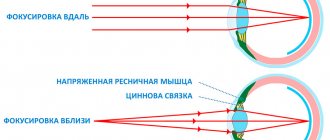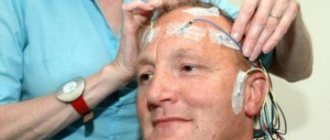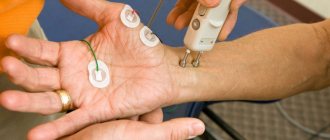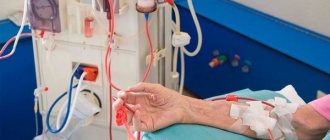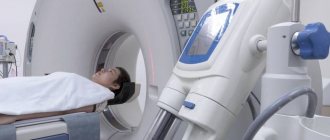A sympatho-adrenal crisis, also called a panic attack, is one of the manifestations of VSD (vegetative-vascular dystonia) of the hypertensive type.
This condition is not a disease, but a condition that manifests itself in the form of an acute attack, which is accompanied by an increase in heart rate, chest pain, a sharp rise in blood pressure, as well as an emotional feeling of fear.
The most common time for a crisis to occur is the second half of the day or night.
This fact is explained simply - during the day the body accumulates both physical and emotional fatigue, which can cause a panic attack.
Read more about panic attacks in our materials:
What happens during a crisis
Let's take a closer look at what happens during the onset of a sympatho-adrenal crisis.
Physical manifestations: a headache occurs, breathing becomes difficult, a feeling of lack of air appears, trembling occurs throughout the body, the sensitivity of the skin may be impaired, even a light touch causes pain, the limbs become cold, the body temperature rises.
In addition, as mentioned above, the heart rate increases and blood pressure rises.
At the time of a sympathoadrenal crisis, the human body experiences an overdose of adrenaline, which is released into the blood in a very significant volume.
Emotional manifestations: the patient develops a feeling of fear, often the person experiences fear of imminent death, unreasonable horror, ceases to trust others and believes that he is in danger.
As a rule, the duration of a crisis does not exceed 1-2 hours , although some patients claim that in fact a panic attack lasts much longer - up to 8 hours. However, even in such a short period, the body is subjected to a colossal test and experiences great stress.
The end of the attack occurs suddenly and is characterized by a feeling of powerlessness and weakness.
The intense work of the kidneys during a crisis results in copious urination, and the urine becomes very light.
After a crisis, it is recommended to remain calm, try to relax or distract yourself with some pleasant activity. This is necessary so that thoughts about the experience do not provoke a second attack.
At the moment, medical practice shows that the treatment of sympathoadrenal crises is quite successful.
Modern techniques and medications, selected by a professional doctor, have a positive effect and help cope with this condition. However, without the desire of the patient himself to overcome the panic state, the specialist will not be able to help fully.
Therefore, only through interaction between the doctor and the patient can the maximum effect be achieved and individual factors that provoke the development of a sympatho-adrenal crisis be overcome.
Therapy for sympathoadrenal crisis
Adrenal crisis has symptoms of both autonomic dysfunction in the body and emotional disorders, so treatment must be comprehensive - medication and psychotherapy, and an individual treatment regimen for each patient is important. But the healing process must begin with a complete revision of the patient’s lifestyle.
You need to establish a rhythm of life: get enough rest (get at least 7–8 hours of sleep, go to bed before midnight), avoid physical and mental overload. The diet will also have to be changed: minimize fatty foods, drinks that excite the nervous system, and enrich the diet as much as possible. Avoid stressful and traumatic situations, any negative external influences. Increase physical activity, especially outdoors. Learn to relax and “work through” emotions.
Many techniques for working on your character can be found on the Internet. For example, the advice of Nikita Valerievich Baturin, a specialist in combating fears and psychosomatics, will be useful.
Treatment with medications
Drug treatment of sympathoadrenal crises is indicated primarily for moderate and severe degrees of the disease. The following groups of drugs can be prescribed by a doctor:
- Tranquilizers reduce the excitability of the central nervous system. Medicines of this series relieve symptoms, but do not eliminate the causes of adrenal crises. Apply for a short period at the beginning of treatment.
- Beta blockers can neutralize the effect of adrenaline and thus stop or prevent an attack.
- Antidepressants are prescribed for a long time (from six months to a year), but after discontinuation, relapse is still possible.
- Sedative herbal medicines based on sage, motherwort, valerian, and hawthorn are an alternative to complex sedatives. The course of treatment is long - 6–12 months.
- To improve blood supply to tissues, especially in the presence of ischemia, Cinnarizine and Cavinton are prescribed.
- Nootropic drugs improve the metabolism of nerve tissue.
Attention! Independent selection of medications is strictly prohibited. Prescription of medications for the treatment of sympathoadrenal crisis is carried out only by a qualified specialist.
Psychotherapeutic treatment
Observation and treatment by a psychotherapist can reduce the symptoms of sympathoadrenal crises already at the beginning of therapy. During individual or group psychotherapeutic sessions for the treatment of sympathoadrenal crisis, two goals must be achieved:
- Convince the patient that an adrenal crisis should not be expected to pose a threat to life or complications, and that it is not a sign of severe internal illness.
- Change the patient’s existing stereotype of behavior, his attitude towards people around him and the world, as well as towards himself.
In the course of working with a psychotherapist, psychological conflicts are identified that have not found a way out and are not recognized by the patient. In case of relapse of attacks, repeated courses of psychotherapy are effective.
The patient’s independent work on his character, the development of self-control, and the ability to relax will bring closer the desired result in overcoming the disorder. Useful information and specific advice can be found on the channel of psychologist Nikita Valerievich Baturin
Causes of crises
The very concept of “crisis” in the name of the condition under consideration indicates the presence of an extreme situation for the body, which leads to a negative reaction. What reasons can provoke sympathoadrenal crises?
These can be either internal psychological or physical problems, or external factors that cause emotional disorders.
Internal psychological reasons
People who are used to suppressing their emotions often suffer from panic attacks.
They cannot allow themselves to fully experience any shocks, both positive and negative, and as a result live in a state of stress.
However, emotions accumulated over a long period can negatively affect not only a person’s moral state, but also the body, finding a way out in a sympatho-adrenal attack.
Bad habits can also be included in this category of influencing factors.
Dangerous, unpredictable and difficult to predict - hepatic encephalopathy. What methods of diagnosis and treatment does modern medicine offer? Fruitless verbosity or resonant thinking. Real life examples of violations. Which brain centers are affected in such cases.
Internal physical reasons
These include various health disorders that can provoke a sympatho-adrenal crisis.
Among them:
- a neoplasm (tumor) in the adrenal medulla, which contributes to the release of a high volume of adrenaline into the blood (and regardless of the psychological state of the patient);
- disorders that increase stimulation of the central part of the sympathetic system in the spinal cord (tumor of the spinal cord, spine, ischemia);
- the presence of pathological impulses of areas of the brain associated with the sympathetic system and hypothalamus (similar to epileptic seizures);
- the presence of a neuroinfection, as well as a past illness associated with a neuroinfection;
- suffered traumatic brain injuries;
- disruption of the normal balance of hormones in the body;
- some disturbances in the functioning of the cardiovascular system;
- some diseases of the gastrointestinal tract and digestive system.
External factors
First of all, this category of reasons includes emotional stress arising as a result of any events affecting the patient.
They can be both positive and negative (more often they provoke a panic attack).
With a strong psychological shock, the brain gives the adrenal glands a command to release large amounts of adrenaline, which leads to a sympatho-adrenal crisis.
In addition, an external factor may be the tendency of close relatives to have panic attacks, which can cause a hereditary predisposition.
It should be noted that in one patient a sympatho-adrenal crisis can be provoked by different factors, and they will not always be the same during repeated attacks.
What is a vegetative crisis, how is it classified?
A vegetative crisis is an extreme form of expression of VSD (vegetative-vascular dystonia), which is characterized by a disorder of the nervous system. In the International System of Classification of Diseases (ICD), this pathology is coded F 41.0.
The classification of vegetative crises is carried out according to several types, which is determined by the severity of the disease and the totality of the existing symptoms.
Depending on the severity of the course, a vegetative crisis can be:
- light – lasts a maximum of half an hour. Accompanied by minor but characteristic violations;
- medium – lasts about an hour. This form is characterized by multiple somatic disorders with the further formation of asthenia (neuropsychic weakness), which persists throughout the day;
- severe – lasting more than an hour. The appearance of various disorders is noted, accompanied by various paroxysms and the subsequent development of asthenia, which persists for several days.
In modern medicine, vegetative crises are also divided into 4 types in accordance with the symptoms that appear. According to this classification they are:
- sympathetic-adrenaline. Manifested by severe anxiety, discomfort in the heart, rapid pulse and high blood pressure;
- vagoinsular. The patient feels his heart sink, then notes the onset of weakness, lack of air, and a decrease in blood pressure;
- vegetative-vestibular. In this case, the person complains of dizziness, vomiting, which appears with a sudden change in posture: turning the head, bending over and other movements;
- hyperventilating. Manifests itself in the form of rapid breathing, increased blood pressure, dizziness, and muscle tone.
The occurrence of any vegetative crisis is acute and unexpected for a person. Sometimes it can appear at night. But such a phenomenon is not dangerous and does not threaten the patient’s life. Although at first glance the clinical picture is quite scary, the attacks always stop, so you should not be afraid of them.
Characteristic symptoms and signs
The sympatho-adrenal crisis develops quite rapidly, and, as a rule, the symptoms appear in aggregate.
Sympathetic adrenal crisis has the following characteristic symptoms:
- difficulty breathing, feeling of heaviness, tightness in the chest;
- feeling of cold or heat, the appearance of tremors of the limbs;
- paleness of the skin;
- a sharp increase in blood pressure, vasospasm;
- headache, throbbing sensation;
- increased heart rate, arrhythmia;
- dry mouth;
- emotional feeling of groundless horror, fear of death.
It should be noted that even the manifestation of symptoms can provoke a relapse of a sympatho-adrenal crisis, so it is very important to try to keep yourself “in control” during the onset of an attack.
Clinical manifestations of vascular paroxysm
Sympathoadrenal crisis
One can expect a variety of manifestations from vegetative paroxysm, therefore the symptoms of a vegetative-vascular crisis will depend on which department holds primacy, that is, the clinical signs will determine the type of paroxysm. Let's say the symptoms of a sympathoadrenal crisis will be as follows:
- Increased blood pressure;
- Sharp, sudden chills;
- Headache and tachycardia, which may become paroxysmal;
- Frequent urination with a significant amount of urine released;
- In some cases, there is a rise in body temperature;
- Dry mouth;
- Feeling of inexplicable anxiety and fear of death.
This crisis could have been provoked by mental and physical overload, stress, and changes in weather.
Vagoinsular crisis
But the vagoinsular crisis in its clinical picture will differ from the sympathoadrenal crisis, although the reasons for their occurrence are the same, and will have approximately the following form:
- A paroxysm simulating an attack of bronchial asthma (in the presence of respiratory neurosis), accompanied by suffocation, or the patient’s complaints of a spasm in the throat;
- Sudden pallor, sudden sweating;
- Nausea, vomiting and other changes in the gastrointestinal tract (bloating and abdominal pain);
- A drop in blood pressure, and therefore fainting;
- Decreased body temperature;
- Heartache;
- Migraine attacks;
- In some cases, paroxysm can develop as an allergic reaction and give rise to Quincke's edema (vaginal paroxysm is characterized by an increase in the levels of histamine, acetylcholine, and serotonin).
Diencephalic crisis
Rich symptoms are characteristic of diencephalic crisis, which is based on lesions of the hypothalamus as a result of:
- Hormonal disorders;
- Exposure to toxic substances;
- Chronic traumatic environment;
- Development of the tumor process;
- Traumatic brain injury and other adverse factors.
In its manifestations, this type is in many ways similar to the vagoinsular type, however, signs of a sympathetic-adrenal crisis also occur. Diencephalic paroxysm is characterized by:
- The rapid development of events, where the patient’s condition worsens, as they say, “before our eyes”;
- Severe vegetative symptoms;
- Pain in the heart and rapid heartbeat;
- Feeling of suffocation;
- Fluctuations in blood pressure and pulse rate;
- Pallor or hyperemia of the face;
- Bluish discoloration of the limbs;
- Pain in the epigastric region, dry mouth, thirst;
- Increased body temperature (possibly up to 39 degrees);
- Chills followed by a feeling of heat;
- Increased urination, sweating;
- Excitement, anxiety, fear of death.
After an attack, the patient usually feels weak and drowsy.
Treatment of sympatho-adrenal crisis
The treatment process usually combines the use of medications and psychotherapy . Preventive measures and the patient’s compliance with certain rules of life are also important.
Emergency assistance during a seizure
Usually, emergency care for a sympathoadrenal crisis is not required, because when an attack approaches, the patient can cope with it independently, taking control of his psycho-emotional state.
However, in difficult cases, it is possible to use sedatives , which quickly relieve the symptoms of a crisis, or other effects according to the symptoms (for example, using a drug to lower blood pressure).
Drug treatment
For treatment at the first symptoms of sympatho-adrenal crisis, the following groups of drugs are used :
- Tranquilizers. For example, alprazolam, phenazepam. Used to reduce the excitability of the central nervous system (CNS). Drugs in this group are also prescribed for the prevention of attacks. However, you should know that tranquilizers do not eliminate the cause of the crisis, but only relieve symptoms, so long-term use of such drugs is not recommended. As a rule, they are prescribed at the beginning of treatment, before the causes of panic attacks are identified.
- Beta blockers. Drugs in this group neutralize the effect of adrenaline, therefore they are used to stop an attack or prevent a crisis when the first symptoms appear. Such drugs include atenolol, anaprilin.
- Antidepressants (Paxil, Cipralex). To obtain a positive effect, such drugs are recommended to be used for a long period (6-12 months). However, after discontinuation of antidepressants, a relapse of sympathoadrenal crisis is possible.
- Herbal medicines that have a sedative effect (sage, motherwort, valerian and others). Used as an alternative to complex sedatives. A positive effect is achieved after taking a course lasting from 6 to 12 months.
It should be noted that in no case should you choose medications on your own; only a qualified doctor should prescribe any drugs to overcome a sympatho-adrenal crisis.
Psychotherapeutic treatment
The patient’s work with a psychotherapist allows one to achieve good results in overcoming panic attacks.
An experienced doctor will help identify the causes of crises, and then work through and neutralize them together with the patient.
At the moment, there are several methods that can be used to solve the problem of sympatho-adrenal crises, so it is possible to select a specific treatment technology individually for each specific case.
How does a crisis occur?
The development of autonomic dysfunction leads to disruption of the innervation of internal organs, affecting the gastrointestinal tract, kidneys and heart, causing arrhythmias, blockades and other cardiac and vascular problems (hypotension, hypertension). In addition, organs and systems, under the influence of mediators, begin to undergo morphological restructuring, as vascular spasm and dystrophy occur in them. As a result of humoral changes, autonomic imbalance is further aggravated.
However, with all the complexity of interactions and transformations at the biochemical and immunological levels, it is clear that a failure that occurs in some small area will entail a change in the state of the entire organism. This will inevitably lead to the development of the pathological process, its chronic course and the occurrence of frequent or rare paroxysms - vegetative crises, where anxiety, fear, and panic are often present. Such symptoms brighten the clinical picture of paroxysm, which is why it is sometimes called a panic attack or a dystonic crisis.
If autonomic dysfunction prefers the cardiovascular system for its localization, then the manifestations of paroxysms will be corresponding. The vessels will respond with spasms or, conversely, with no reaction, but the inconsistency in their work will still be noticeable. Considering that the systems in the human body are interconnected, the manifestations of pathology will be traced in other organs, but with varying degrees of severity.
The clinical picture of a vegetative-vascular crisis will nevertheless indicate the origin of a paroxysm that arose as a result of uncoordinated interaction of parts of the autonomic nervous system. It is impossible to say which is better - the hypotonic, hypertensive type or the cardiac form. All three types can cause an acute disturbance of hemodynamics, and initially the paroxysm will be called a vascular crisis, and only then, with a detailed examination of the patient, the reasons that caused it will become clear.
In principle, vegetative, vascular, vegetative-vascular paroxysm, dystonic or cardiac crisis are concepts so related and difficult to distinguish that their differentiation requires a comprehensive examination of the patient with the study of all neuroendocrine, vegetative and humoral interactions.
The opinion is considered reliably proven that initially, as soon as one department begins to show excessive activity, for example, the sympathetic, then another (in this case, the parasympathetic) also increases the functional level, trying to compensate for the predominance of the first. Sometimes this compensation becomes excessive, which leads to the formation of a crisis with manifestations of inappropriate behavior of both parts of the autonomic nervous system. However, paroxysm clearly indicates a failure of compensation, so often the direction of crises is determined by the initial vegetative tone.
Prevention measures
Factors such as diet, daily routine, and physical activity are not decisive for overcoming attacks. However, following simple preventive measures will reduce the frequency of crises and soften their course.
Prevention measures include:
- walks in the fresh air, moderate but regular physical activity;
- good sleep;
- proper nutrition, taking the necessary vitamins and minerals, it is advisable to divide food into smaller portions, but increase the number of meals;
- refusal of alcoholic drinks and energy drinks;
- reduce the time spent watching TV and reading news on the Internet to reduce the risk of negative emotions;
- It is recommended to avoid stressful situations if possible.
Other perivascular crises
CSF crisis, hemolytic crisis, vagoinsular crisis, and vegetative-vascular paroxysm have similar symptoms
However, the causes of all these attacks are different, therefore treatment is selected individually in each case.
That is why, if alarming symptoms appear, you should consult a doctor who, after conducting diagnostic measures, will be able to accurately determine the type of crisis and prescribe the necessary course of treatment.


